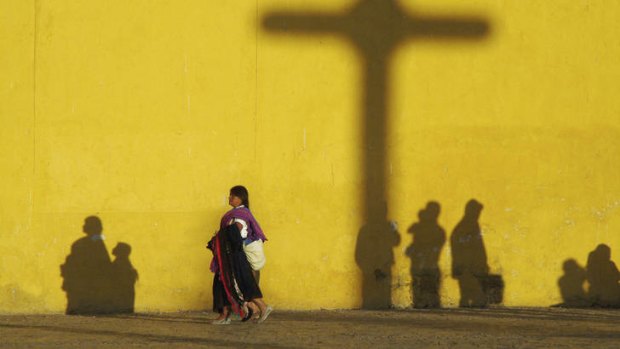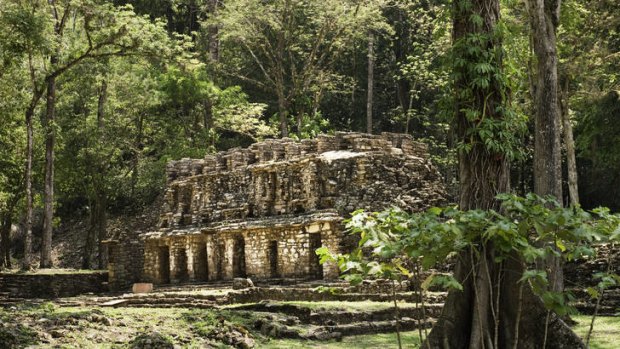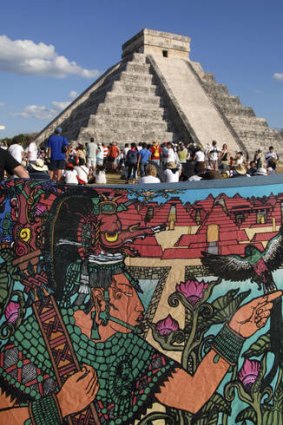
San Cristobal de las Casas.Credit: Getty Images
New archaeological finds are quickening interest in the Maya, whose history is shrouded in myth, writes Nigel Richardson.
Between the ruined Mayan cities of Kabah and Uxmal, in the Mexican state of Yucatan, there is a red church on a hill. The interior is lined with strange wooden shrines, their doors ajar like cabinets of curiosities. A caretaker who is clearing away the guttered candles welcomes us and says sadly, "We don't hold so many religious festivals these days. Because of the chupacabra, you see."
The chupacabra? It translates literally as "goat-sucker" - a cryptid or mythical beast that the villagers of Santa Elena believe preys on livestock. If you hold a festival you are just asking for the chupacabra to saunter along and pick off the goats and pigs you bring to feed the festival-goers. So, they figure, it's best not to hold festivals in the first place.
Superstition runs deep here - as deep, indeed, as el inframundo, the underworld, which underpinned the beliefs of the old Mayan civilisation of Mexico and Central America.
This year, the eyes of the world are turning afresh on this extraordinary people and period of history. This is because, according to selective interpretation of Mayan cosmology, time reaches its sell-by date on December 21, or possibly December 12.
In May, a discovery at the Mayan site of Xultun in Guatemala uncovered hieroglyphs that represent the oldest known Mayan calendar. It's a reminder that the Maya were the original time lords.

Yaxchilan archeological site in the jungle.Credit: Getty Images
When the conquistadors arrived in the town of San Cristobal de las Casas in the 1520s, the glories of Mayan civilisation were long past.
The Spanish found a hostile people steeped in heretical beliefs and promptly imposed Roman Catholicism on them, destroying the temples and icons and punishing the old ways, often brutally.
The Maya took on the outward forms of Catholic observance and, today, many remain deeply religious.

The pyramid of Chichen Itza.Credit: Reuters
In the church of Santo Domingo in San Cristobal, the devoutness of a huddled old couple is palpable - but their expressions of devotion are strange.
"He is 'pulsing' her," whispers Hector, our guide, indicating the man's fingers on the woman's wrist.
"He is a healer. The Maya believe that blood is the path to the spirit world. They can tell what is wrong with you by feeling your pulse, and make you feel better."
The healers are the priests of the old belief system. To witness them at work, we drive 10 kilometres north-west to the Mayan village of San Juan Chamula, where the Day of San Sebastian is being celebrated with music, revels and devotion.
In a church strewn with pine needles, festooned with white flowers and heady with copal incense, a band plays - deafening drums and trumpets - kneeling shamans heal pilgrims by holding sacrificial chickens above their bodies, then wringing the fowls' necks, and intoxicated men swig posh (cane liquor) from old soda bottles.
They don't keep it all to themselves, however; every second mouthful they blow over worshippers in a mist of clear alcohol.
As we watch - strictly no photographs, or even note-taking - a healer lights two small candles and places them at our feet. This is to ward off fear, according to Mayan ritual, but the healer has slightly misread our expressions. It is amazement, not fear, we feel. For a moment, we feel transported to pre-Hispanic times.
Even more evocative is our next stop, the remote ruins of Yaxchilan, near the Chipas Highlands. The only way to reach them is on a 40-minute motorboat ride along the Usumacinta River, which forms the border with Guatemala. The site appears abruptly on the southern river bank - a tangle of vegetation and stone terraces like a skeleton in its rotting shroud.
Here, the light is green and brooding, filtered through vast rainforest trees with serpent-like surface roots.
Parrots and howler monkeys screech and bellow through the tree canopy, while bats hang in the clammy tunnels of the labyrinth.
Apart from a brief flurry of noise and movement produced by an Italian tour group, we have the stelae, altars, hilltop temples and subterranean passageways of Yaxchilan all to ourselves.
For many years, scholars had an idealised view of the culture that had produced such places. But there was another side, summed up in two words: human sacrifice.
It is the discovery of the next site on our itinerary, Bonampak, that sheds new light on the nature and extent of sacrificial practices, darkening history's view of the Mayan civilisation. I have a personal interest in Bonampak because I know the daughter of the man who "discovered" it, an American photographer and adventurer named Giles Healey. Bonampak is buried deep in the jungle in the lands of the Lacandon Indians, a Mayan group, near what is now the Guatemalan border. This region is so remote it was not colonised by the Spanish, and the Lacandon were never converted to Catholicism.
In 1946, Healey was led to the overgrown site by two Lacandon who had stumbled on it while hunting with bows and arrows.
Nowadays Lacandon taxi drivers, distinctively long-haired and wearing white robes, ferry visitors the last kilometres to the site.
Our driver says matter of factly, "Giles Healey? Oh, yes. My mother's brother was Pepe Chambor. He was the one who showed Healey the murals."
Bonampak is relatively small and unremarkable - except for one feature. In a temple on a hill there are three chambers covered in paintings, of a graphicness and sophistication found nowhere else in the Mayan world.
They depict a battle and its aftermath. A band plays. Prisoners plead for their lives as they are tortured by having their fingernails pulled out. A severed head rolls down steps. White-robed women practise auto-sacrifice by piercing their tongues, and bird men bleed their penises. The world portrayed and celebrated here is bizarre and unsettling.
Murals at the grandest Mayan site of all, Chichen Itza in Yucatan, tell a similarly brutal story, and it is thought that the sacrifice of humans at Chichen Itza's sacred cenote, a well of some 60 metres in diameter, continued into colonial times.
The day after visiting Chichen Itza, we drop in on the church of Santa Elena, the red church on the hill that is haunted by the mythical goat-sucker. In 1980, during restoration work, the bodies of 12 children were found buried beneath the church.
The part-mummified remains of four of them lie in little wooden coffins in a museum next door. These children died probably no more than 200 years ago, in what circumstances no one knows.
But, having just heard about the chupacabra, and mindful of the sacrificial well at Chichen Itza, I think it possible the children were sacrificed, following pre-Hispanic Mayan tradition, and the time lords of the Classic Period were still pulling strings long after their demise.
Telegraph, London
FAST FACTS
Getting there Qantas has a fare to Mexico City from Sydney and Melbourne for about $1895 low-season return, including tax. Fly non-stop to Los Angeles (about 14hr) and then non-stop to Mexico City (3hr 35min with Alaska Airlines); see qantas.com.au. As you are transitting the US, you must apply for US travel authorisation before departure at https://esta.cbp.dhs.gov.
Touring there The writer's tour of Mayan Mexico was arranged by Journey Latin America (+44 20 8747 8315; journeylatinamerica.co.uk). A 15-day trip costs from £2061 ($3158) a person, visiting Chiapas and Yucatan and taking in Mexico City and a beach stay in Tulum on the Caribbean coast. The price includes private excursions to the sites, land transport, breakfast and three domestic flights.
Sign up for the Traveller Deals newsletter
Get exclusive travel deals delivered straight to your inbox. Sign up now.